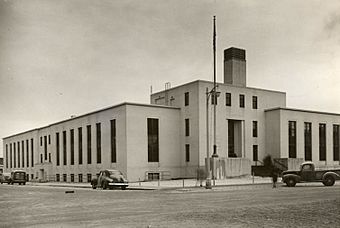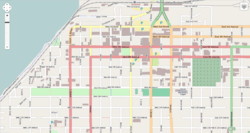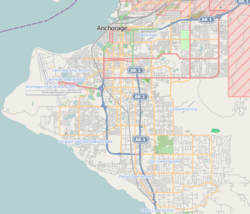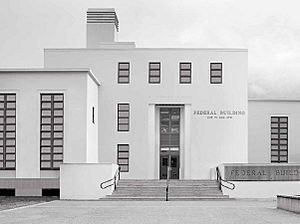Old Federal Building (Anchorage) facts for kids
|
Federal Building-U.S. Courthouse
|
|

The Federal Building in Anchorage, Alaska, in 1941
|
|
| Location | 601 West 4th Avenue, Anchorage, Alaska |
|---|---|
| Area | 2.1 acres (0.85 ha) |
| Built | 1939 |
| Architect | Multiple |
| Architectural style | "New Deal Concrete" |
| NRHP reference No. | 78000516 |
Quick facts for kids Significant dates |
|
| Added to NRHP | June 23, 1978 |
The Old Federal Building in Anchorage, Alaska is a historic building that mainly served as a courthouse for the United States District Court for the District of Alaska. It was built in stages between 1939 and 1941. In 1978, it was added to the National Register of Historic Places, which lists important historical places in the U.S.
Contents
A Historic Building for Alaska
This building was constructed almost 20 years before Alaska became the 49th state in the United States. It showed that the U.S. government was serious about helping Alaska grow and develop. The Federal Building was the first large federal building in Anchorage. It offered a post office, a courthouse, and other government services to the people living there.
Building's Early Days
The land where the building stands was set aside in 1915 for a Federal Reserve Bank. The first building on this spot was a post office. Later, a U.S. Marshal's office and a local jail were built there. These smaller buildings were later taken down to make room for the Federal Building we see today.
Who Designed the Building?
Gilbert Stanley Underwood (1890–1961) designed the first part of the building in 1939–1940. He also designed the west wing, which was added in 1940–1941. Underwood was a famous architect from Los Angeles. He was known for designing lodges in National Parks. He also worked for the government, designing several federal buildings.
Growing with Alaska
The Old Federal Building was home to many different government groups. These included the Civilian Conservation Corps (a program that helped people find work during the Great Depression), the United States Department of the Interior, and the Signal Corps. The building grew over time to fit all these groups.
- The first addition, a wing for the post office, was finished in 1940–1941.
- In 1958, a new section was built in the courtyard for the Third District Court.
- In 1991, another addition was made for the National Archives and Records Administration (NARA).
This building was an early symbol of the U.S. government's presence in Alaska. It helped Alaskans feel more connected to the rest of the country. When Alaska became a state in 1958, a huge American flag with 49 stars covered the building's front. One star was even highlighted to celebrate Alaska's new statehood.
Building's Design and Features
The Old Federal Building is made of reinforced concrete. It has a flat roof and a low wall around the top. The original plan was to build a square building with a large courtyard in the middle. However, it quickly became clear that more space was needed. So, additions were built to expand the building. Even with these changes, the main parts of the building still look much like they did when they were first built.
Outside the Building
Most of the building has two stories and a basement. The east and west ends of the south side have three-story sections above the main entrances. The southeast entrance originally led to the courtroom. The southwest entrance led to the post office. The building does not have many fancy decorations on the outside. Its most unique feature is its tall, narrow windows. These windows make the building look taller.
Inside the Building
The inside of the building is also simple but has many original features. The stairwells, hallways, and old post office areas have ceramic tiles on the lower walls and tiled floors. The stairwells also have their original steel posts, iron railings, and wooden handrails. You can still find old ceramic drinking fountains in the hallways. The ceilings in the entry areas have a cool stepped design. The light fixtures in the lobbies and the ceilings in the hallways are also original. The doors in the hallways are not original, but they look just like the first wooden doors with glass panels.
The Courtroom Mural
The most important room inside is the original federal district courtroom on the first floor. This room still has its original wooden walls and benches. Behind where the judge sits, there is a large oil painting called "Alaskan Landscape." This mural was painted by Arthur Kerrick in 1942 as part of a program called the Works Progress Administration (WPA), which helped artists find work. The painting was installed in the 1950s. Five murals were planned for the courtroom, but only this one was finished.
Quick Facts About the Building
- Location: 605 West Fourth Avenue
- Architect: Gilbert Stanley Underwood
- Built: 1939–1941
- Style: 1930s Modern
- Important Status: Listed in the National Register of Historic Places
- Main Material: Concrete
- Key Features: Tall vertical windows, concrete exterior, special woodwork, and a WPA mural in the courtroom.





